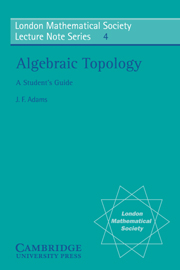Book contents
- Frontmatter
- Contents
- INTRODUCTION
- PAPERS ON ALGEBRAIC TOPOLOGY
- 1 Combinatorial homotopy
- 2 An axiomatic approach to homology theory
- 3 La suite spectrale. 1: Construction générale
- 4 Exact couples in algebraic topology
- 5 The cohomology of classifying spaces of H-spaces
- 6 Cohomologie modulo 2 des complexes d'Eilenberg-MacLane
- 7 On the triad connectivity theorem
- 8 On the Freudenthal theorems
- 9 The suspension triad of a sphere
- 10 On the construction FK
- 11 On Chern characters and the structure of the unitary group
- 12 Espaces fibrés et groupes d'homotopie. I, II
- 13 Generalised homology and cohomology theories
- 14 Relations between ordinary and extraordinary homology
- 15 On axiomatic homology theory
- 16 Characters and cohomology of finite groups
- 17 Extract from thesis
- 18 Relations between cohomology theories
- 19 Vector bundles and homogeneous spaces
- 20 Lectures on K-theory
- 21 Vector fields on spheres
- 22 On the groups J(X). IV
- 23 Summary on complex cobordism
2 - An axiomatic approach to homology theory
Published online by Cambridge University Press: 23 May 2010
- Frontmatter
- Contents
- INTRODUCTION
- PAPERS ON ALGEBRAIC TOPOLOGY
- 1 Combinatorial homotopy
- 2 An axiomatic approach to homology theory
- 3 La suite spectrale. 1: Construction générale
- 4 Exact couples in algebraic topology
- 5 The cohomology of classifying spaces of H-spaces
- 6 Cohomologie modulo 2 des complexes d'Eilenberg-MacLane
- 7 On the triad connectivity theorem
- 8 On the Freudenthal theorems
- 9 The suspension triad of a sphere
- 10 On the construction FK
- 11 On Chern characters and the structure of the unitary group
- 12 Espaces fibrés et groupes d'homotopie. I, II
- 13 Generalised homology and cohomology theories
- 14 Relations between ordinary and extraordinary homology
- 15 On axiomatic homology theory
- 16 Characters and cohomology of finite groups
- 17 Extract from thesis
- 18 Relations between cohomology theories
- 19 Vector bundles and homogeneous spaces
- 20 Lectures on K-theory
- 21 Vector fields on spheres
- 22 On the groups J(X). IV
- 23 Summary on complex cobordism
Summary
The following note by Eilenberg and Steenrod is the first announcement of their axiomatic approach to homology theory. Of course, this work has influenced later developments very strongly. It should perhaps be pointed out that in 1945, when this note appeared, we had essentially no examples of what are now called ‘generalised homology theories’; nor did we have the techniques, such as spectral sequences, which are now used for dealing with them. The only prerequisite is a minimal acquaintance with homology groups (see §1 of the introduction).
Introduction.—The present paper provides a brief outline of an axiomatic approach to the concept, homology group. It is intended that a full development should appear in book form.
The usual approach to homology theory is by way of the somewhat complicated idea of a complex. In order to arrive at a purely topological concept, the student of the subject is required to wade patiently through a large amount of analytic geometry. Many of the ideas used in the constructions, such as orientation, chain and algebraic boundary, seem artificial. The motivation for their use appears only in retrospect.
Since, in the case of homology groups, the definition by construction is so unwieldy, it is to be expected that an axiomatic approach or definition by properties should result in greater logical simplicity and in a broadened point of view. Naturally enough, the definition by construction is not eliminated by the axiomatic approach. It constitutes an existence proof or proof of consistency.
- Type
- Chapter
- Information
- Algebraic TopologyA Student's Guide, pp. 46 - 50Publisher: Cambridge University PressPrint publication year: 1972



